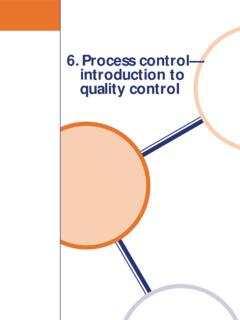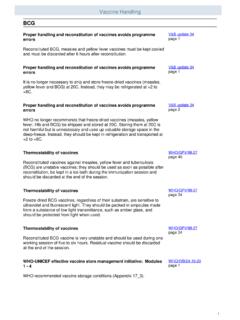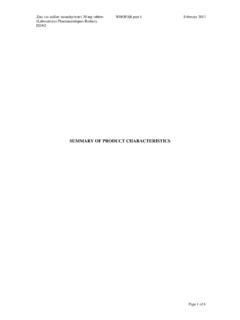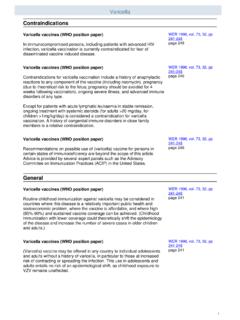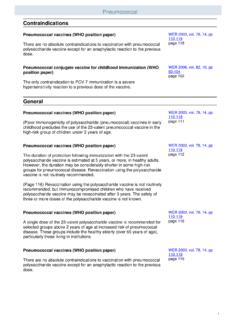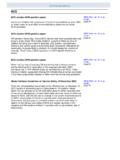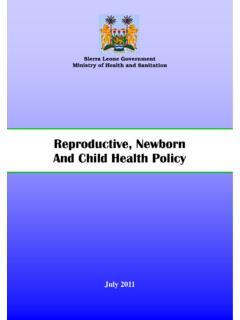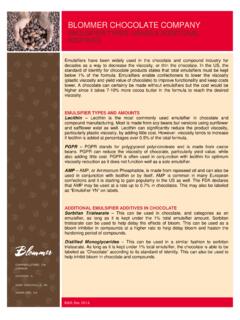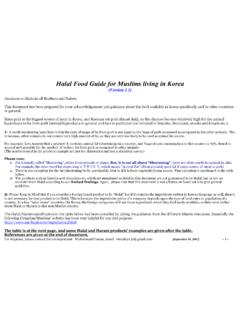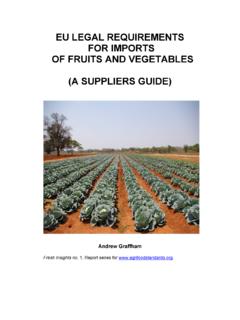Transcription of Guidelines: Saturated fatty acid and trans-fatty acid ...
1 Draft guidelines on Saturated fatty acid and trans- fatty acid intake for adults and children Guidelines: Saturated fatty acid and trans- fatty acid intake for adults and children Contents Acknowledgements .. 2 Abbreviations and acronyms .. 2 Executive summary .. 3 Introduction .. 15 Scope and purpose .. 15 Background .. 16 Guideline development process .. 18 Advisory groups .. 18 Scoping of the guideline, evidence appraisal and decision-making .. 20 Management of conflicts of 20 Summary of evidence .. 21 Saturated fatty acids.
2 21 Trans- fatty acids .. 30 Recommendations and remarks .. 37 Dissemination, translation and implementation, and monitoring and evaluation .. 43 Dissemination .. 43 Translation and implementation .. 44 Monitoring and evaluation of guideline implementation .. 45 Research gaps and future initiatives .. 46 Implications for future research .. 46 Updating the guideline .. 47 Annex 1: GRADE evidence profiles .. 48 Annex 2: WHO Secretariat .. 85 Annex 3: Members of the WHO Steering Committee for Nutrition Guideline Development 85 Annex 4: Members of the guideline development group (NUGAG Subgroup on Diet and Health) and external resource persons.
3 85 Annex 5: External peer-review group .. 85 Annex 6: Priority questions in the format of population, intervention, control and outcomes (PICO) .. 86 Annex 7: Summary of considerations for determining the strength of the 91 Annex 8: Management of conflict of interest .. 97 1 Draft guidelines on Saturated fatty acid and trans- fatty acid intake for adults and children Acknowledgements ( To be completed) Abbreviations and acronyms BMI body mass index CHD coronary heart disease CI confidence interval CLA conjugated linoleic acid CVDs cardiovascular diseases eLENA WHO e-Library of Evidence for Nutrition Actions FAO Food and Agriculture Organization of the United Nations GINA WHO Global Database on the Implementation of Nutrition Action GRADE Grading of Recommendations Assessment.
4 Development and Evaluation HDL high -density lipoprotein HOMA-IR homeostasis model of insulin resistance kcal kilocalorie kJ kilojoules LDL low -density lipoprotein MD mean difference MUFA monounsaturated fatty acids NCDs noncommunicable diseases NUGAG WHO Nutrition guidance Expert Advisory Group PICO population, intervention, comparator and outcome PUFA polyunsaturated fatty acids RCT randomized controlled trial RR risk ratio SFA Saturated fatty acids SMD standardized mean difference TFA trans- fatty acids USA United States of America WHO World Health Organization 2 Draft guidelines on Saturated fatty acid and trans- fatty acid intake for adults and children Executive summary Background Noncommunicable diseases (NCDs) are the world s leading cause of death.
5 They were responsible for an estimated million (72%) of the million deaths in 2016 (1). Many of those deaths were premature ( under the age of 70 years) and occurred in low- and middle-income countries. Of the major NCDs, cardiovascular diseases (CVDs)1 w ere the leading cause of NCD mortality in 2016 , being responsible for nearly half (45%) of all NCD deaths. Modifiable risk factors such as unhealthy diet , physical inactivity, tobacco use, and harmful use of alcohol are major causes of CVDs.
6 Dietary Saturated fatty acids and trans- fatty acids are of particular concern because high levels of intake are correlated with increased risk of CVDs (2). Saturated fatty acids are fatty acids containing only single carbon carbon bonds ( no double bonds). Saturated fatty acids are found in foods from animal sources such as butter, cow s milk, meat, salmon and egg yolks, and in some plant-derived products such as chocolate and cocoa butter, and coconut, palm and palm kernel oils. Trans- fatty acids are unsaturated fatty acids with at least one double carbon carbon bond in the trans configuration.
7 Trans- fatty acids can be produced industrially by the partial hydrogenation of vegetable and fish oils, but also occur naturally in meat and dairy products from ruminant animals ( cattle, sheep, goats, camels). Industrially-produced trans- fatty acids can be found in baked and fried foods, pre-packaged snacks and food, and partially hydrogenated cooking oils and fats which are often used at home, in restaurants, or in the informal food sector (such as street vendors), and are the predominant source of trans- fatty acid intake in many populations.
8 Reduced intake of Saturated fatty acids has been associated with a significant reduction in risk of coronary heart disease (CHD) when replaced with polyunsaturated fatty acids (PUFA) or carbohydrates from whole grains (3-6). Similarly, studies have demonstrated that high intakes of industrially-produced trans- fatty acids are strongly associated with increased risk of CHD and related mortality (7, 8). Few studies have identified an association between intake of ruminant trans- fatty acids and CVDs; however, to date, ruminant trans- fatty acid intake in most study populations has been very low (9).
9 The reduction in risk of CVDs seen with decreased intake of Saturated fatty acids and trans- fatty acids is believed to occur primarily through an effect on blood lipids, because intakes of both are positively correlated 1 Cardiovascular diseases include coronary heart disease, cerebrovascular disease ( stroke), structural abnormalities of the heart at birth or damage resulting from rheumatic fever, peripheral arterial disease, and deep vein thrombosis and pulmonary embolism. 3 Draft guidelines on Saturated fatty acid and trans- fatty acid intake for adults and children with total and low-density lipoprotein (LDL) cholesterol1 levels (10, 11).
10 Total cholesterol has been shown to be positively associated with CHD (12), and LDL cholesterol is a well-established biomarker for measuring the effects of interventions on CVD risk (13-15). Although there have been few studies of trans- fatty acid intake in children, results of dietary intervention studies conducted in children have demonstrated significant reductions in total cholesterol, LDL cholesterol, or both, when Saturated fatty acids were replaced with PUFA (16-21). Objective The objective of these guidelines are to provide recommendations on the intake of Saturated fatty acids and trans- fatty acids to reduce the risk of NCDs in adults and children, particularly CVDs which are a leading cause of NCD mortality.

